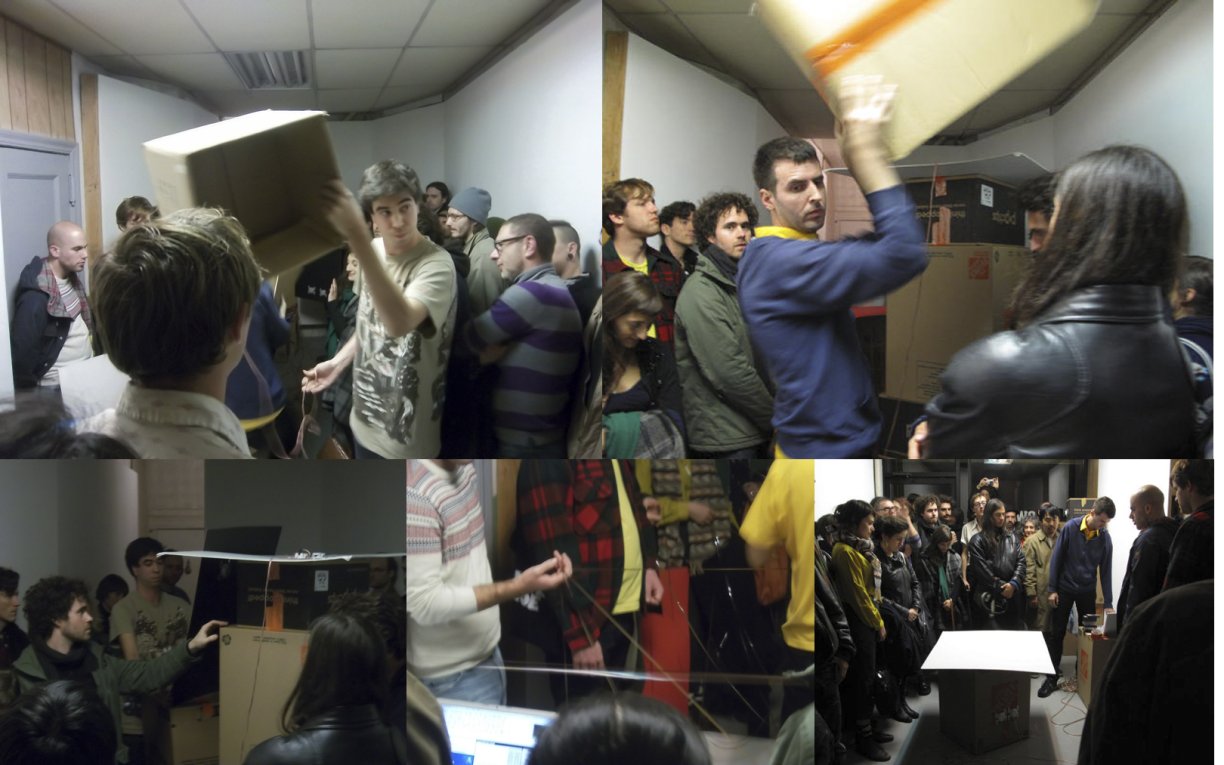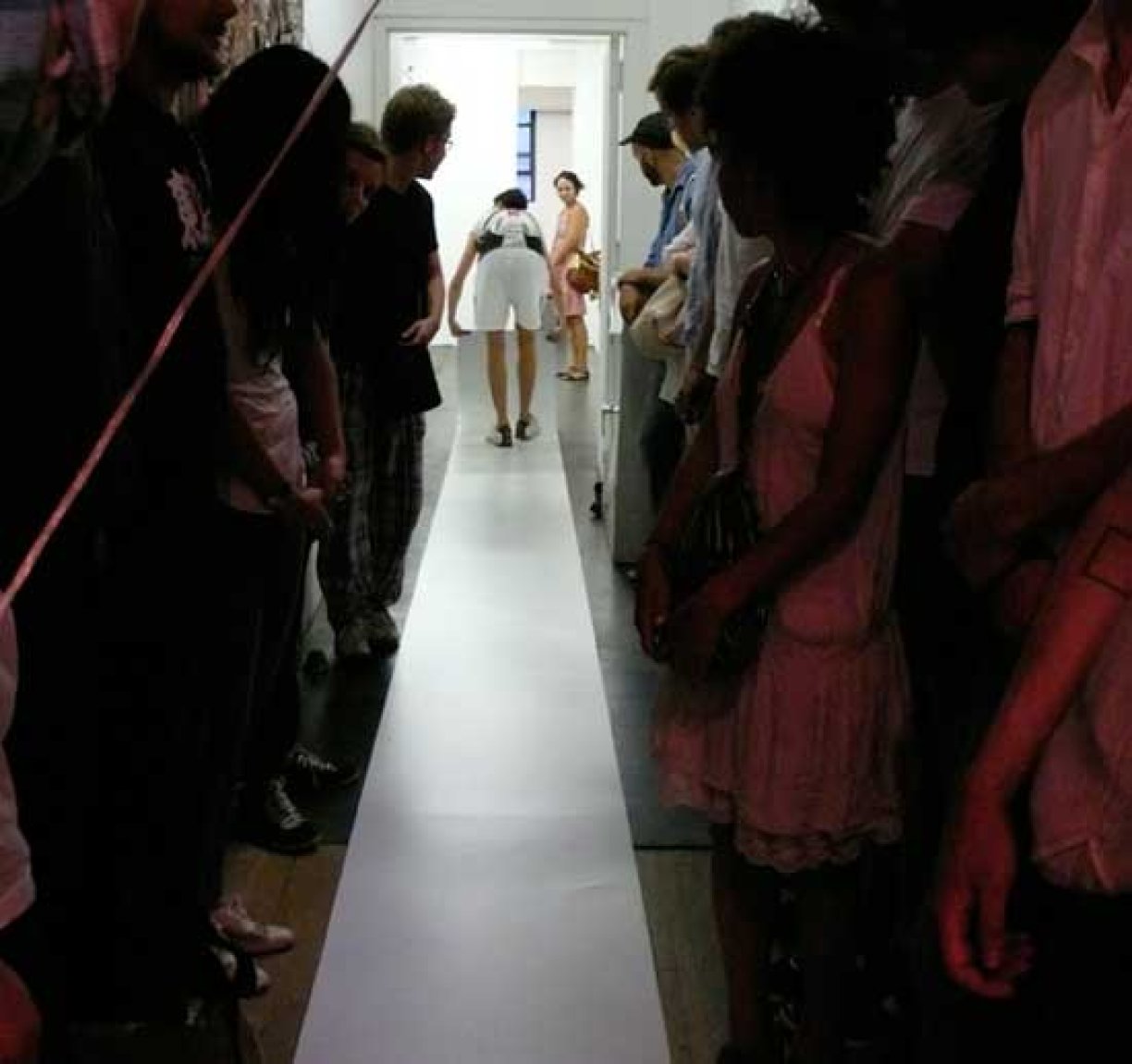Artist-in-Residence Sergei Tcherepnin gives the first performance of his residency with Woody Sullender on April 4, 2012. Tcherepnin and Sullender construct sites for listening, touching, and direct engagement with sonic material. Their temporary architecture of tactile speakers disperses the duo’s live electronic music in performance. In April, they present their largest-scale piece yet: a work that includes rooms within rooms, difference tone doorways, and listening tables. As objects and bodies are reorganized in space, musical and physical structures will emerge and disappear.
Woody Sullender: We first started working together casually maybe a couple of years ago. Recently, we’ve become focused on something with a much more rigorous approach that is a bit different from our improvised or electronic music backgrounds. How would you explain our project?
Sergei Tcherepnin: To start, we are making electronic music without speakers. We’ve both been using transducers in our respective practices – you were using them in an interesting way to reinvent the acoustic banjo by playing live processed sound through the materiality of the instrument itself – while I was starting to make projects turning cardboard and metal into flexible, tactile speakers for pre-recorded compositions.
We have since developed a project together where we build spaces for listening and touching sound material which is somewhere between live improvised music and a sonic topography. Furthermore, we are building these installation/performances not only as locations where one can become absorbed in sound, but also as scenarios with which we can explore power dynamics between audience and performers.
WS: The only other thing is that we also construct the performance as a series of gestures that can be read in a number of ways. For instance, we started out our last performance by building something table-like out of materials vibrating with our music.
It is interesting that before collaborating we both individually worked with Maryanne Amacher and Ei Arakawa. In fact, I believe our first performance together was with Ei. How do you think Maryanne and Ei have informed our project?
ST: In our performance with Ei, I remember being really excited that we were playing together, but also unsure if we were actually supposed to respond to each other like “regular” improvisers or ignore each other as part of the collage of events. I think this uneasiness or awkwardness made our part of the performance more interesting than if we were to have just set up a gig and played in automatic improvise mode…performing in Ei’s piece together revealed to us something like a theater of improvisation, and I think that is something that we are still very interested in.
As for Maryanne, we’ve talked a lot about our mutual admiration for her work and spirit, but how do you think she has particularly influenced this project?
WS: Well, I first became aware of Maryanne’s work via the ear tone music on her “Sound Characters” CD which remarkably makes sound come out of one’s own head. I would say our interest in difference tones probably links directly to her. I was drawn to Bill Dietz’s writing around your installation at AVA, where questions arise around what it means to make these subliminal or repressed sounds in one’s own body consciously audible, which is particularly interesting through the lens of current hot topics in biopolitics and embodiment. I think our project develops these ideas of the relationships and significances of bodies in space into this realm of a “theater of improvisation”. Can you elaborate on what you meant by that term?
ST: By theater I mean that the focus on the musical content gives way to an awareness of stage presence or “performance attitudes” of the musicians. Cage, Varèse, and more recently Peter Ablinger have made pieces which examine the customs of classical musicians by taking away the musical content and replacing it with essentially doing nothing (tuning, fiddling, preparing, etc). These pieces bring into focus the given stage behaviors of the musicians. There’s a definite tradition of composers working with theater – Satie and Kagel come to mind as two composers who have made really funny pieces which examine the social role of music.
However not so much of this seems considered in the current world of improvised music which definitely has its own customs and habits. Participating in Ei’s performance at the Japan Society forced us both to step out of our regular contexts for improvised or experimental music, and because of this, the act of playing became part of a theater and also its own theater.
WS: I agree this staging doesn’t seem really considered although there is a long history with musicians like Max Neuhaus, Group Ongaku, and Musica Elettronica Viva leading up to people like Mattin. We also seem to equally be looking to art history as much as music, with artists such as Joseph Beuys and his use of materials and ritual, Alan Kaprow and “happenings,” as well as a variety of contemporary relational artists who shift the performance to the audience in a way that often requires improvisation.
I think our frustration with improvised music is that the performance context seems rather limiting, despite this liberatory discourse. If you go to The Stone night after night, really how different is your experience as an audience member?
More important for me is reconsidering where the site of “music” lies and considering music as a verb and not as a thing. I feel we are asking “what does music do” in the same way as filmmakers like Andy Lampert are examining the cinematic and what film does.
ST: Yeah, I saw Andy’s performance last fall with Flower/Corsano and it was amazing! It felt like he was completely deconstructing the act of projecting in a methodical, matter-of-fact way, but at the same time the viewer could get completely lost in the experience.
For me, this shifting between different modes of experience is really important in opening up a possibility to change frameworks. Sound in particular can have the power to really draw people into a different universe – at the same time it can really aggravate people. That’s a power. Sound can be a drug… sound can be intrusive… concerts can bore people to death… but also, people adjust to sound. Sound can teach you to like it. That’s so strange to me.
WS: This idea of different modes of experience is key, as music is and does very different things based on context. A Lightning Bolt performance obviously functions very differently than a recording of the opening riff of “Dueling Banjos.” Or music like Tony Conrad’s “Slapping Pythagoras” that you can drone out to or read as a conceptual piece about democracy!
I do think our project is trying to approach the sublime in some sense, but also considers what various gestures might represent, whether they are musical or performative. In our last series of performances, some viewers/listeners had a very tactile experience of the music by holding one of our resonating boxes, literally feeling the music in their hands. At the same time, others were helping us make physical structures out of these boxes and discarded cassette audio tape. The work can be read via a more formal music approach, while these gestures can also be read in a variety of ways, as well as the inter-relation between these two approaches.
I do subscribe less to Cage’s “let sounds be themselves” as I’m much more a believer of Eddie Prevost’s “no sound is innocent.” Maybe we could expand this to the larger performance context with something like “no chair is innocent”?
ST: I like that. We need more diabolical audiences. I must say though, I love getting lost in sound – which may be rooted in a desire to be obliterated by sound. This in turn makes me want to make work about that masochism. The hardest thing in my studio sometimes is to snap out of sound’s seduction. I could listen to the same combination of tones for hours, but that isn’t so interesting out of the studio, at least not right now. I think we’re in tricky territory. I’m suspicious of any liberatory discourse.
WS: The notion of liberating audiences or musicians is problematic. I do think revealing or navigating power relations is possible though. Free improvisation does seem specifically about individual musicians working through power – do I follow, do I lead, do I ignore, do I co-exist, do I play over?
In our project, I feel less that we are navigating each other in real time, and more that those issues have been shifted to how we interact with everyone. In our last performance, our sculptural “composition” required a fair amount of help from the audience to make the piece happen. We also left the ending somewhat undetermined so that the decision was made collectively.
ST: I’m really interested in developing these ideas through our performance in relation to Rancière’s notion of the “Ignorant Schoolmaster.” Through an analysis of previous modes of theater like the “total theater” of Artaud or the “epic theater” of Brecht, Rancière argues that there’s potential for something in between. We were talking about this earlier – switching between different modes of experience from immersion/obliteration to an awareness of the frame. In our performances we’re continually trying to figure this balance out. This process is fundamental to the work, as there’s more potential in not knowing the answers.


